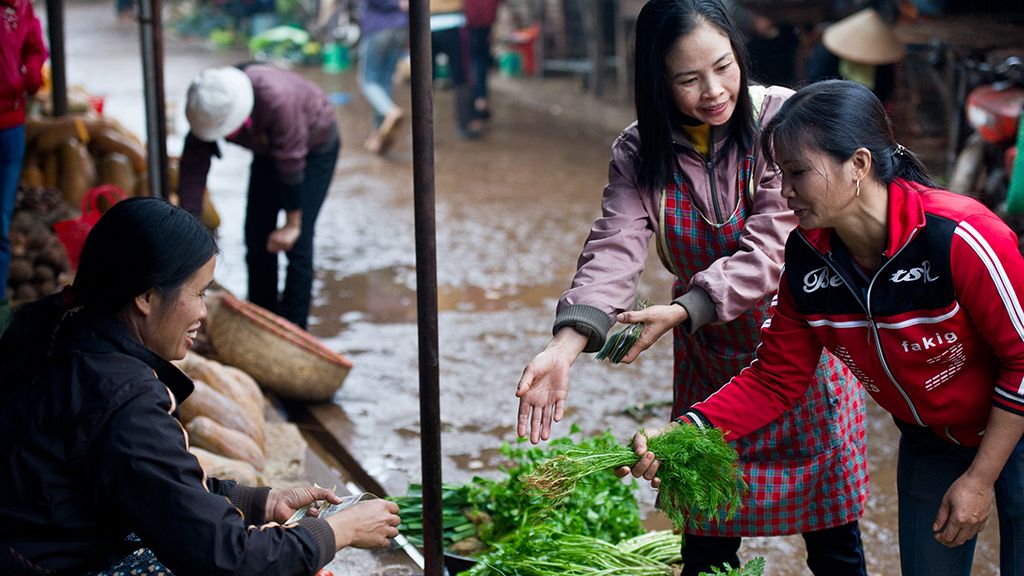“This will require a combination of conserving and managing existing resources more effectively, tapping science to grow food from less land, and drawing in investment to meet growing food demand,” said Mahfuz Ahmed, Asian Development Bank (ADB) Technical Adviser for Rural Development and Food Security.
Climate change is a major food security challenge in Asia with more than 60% of the population, or 2.2 billion people, relying on agriculture and food production for income.
“Developing Asia’s farms are expected to be hit hard by climate change, with production losses estimated at 2-18% for irrigated rice and 2-45% for irrigated wheat by 2050,” said Michiko Katagami, ADB natural resources and agriculture specialist. “Climate change adaptation and mitigation must be central to the food and nutrition security agenda for the region.”
The numbers are stark. By 2030, 65% of Asians will live in cities. With an additional 3 billion consumers expected to join the middle class by 2030, food demand will rise by up to 70%. Available water supplies are shrinking in the face of increasing demand from consumers and competition from the agriculture and energy sectors. Around 70% of Asia’s surface water is used for agriculture, but much of it is used inefficiently. Many water-stressed countries lose large volumes of treated water through leakage in water supply systems. Asia is running out of water for the future.
Now rising temperatures, increasing droughts and floods and other weather extremes are more worrying threats to food security. By 2050, expected crop yield reduction for irrigated paddy is 14–20%; for irrigated wheat, 32-44%; irrigated maize, 2–5%; and irrigated soybean, 9–18%. Rice prices are projected to be 29–37% higher in 2050 compared to a no-climate change case; wheat prices will be 81–102% higher, maize prices will rise 58–97%, and soybean prices are set to increase 14–49%.
Multi-sector engagement
ADB’s multisector approach to sustainable food security in developing Asia has resulted in improved water productivity such as irrigation, drainage, and water storage; increased resilience against natural disasters with flood-prone, drought-prone rice varieties; and enhanced regional food security through an emergency food reserve system.
In India and Bangladesh, more than 5 million hectares of rice fields are flooded during most of the planting seasons. With the International Rice Research Institute (IRRI), rice varieties withstanding floods were developed. Work was done on the development and dissemination of rice varieties for water-short areas in India, Nepal, Bangladesh, Laos, Cambodia, and the Philippines. Rice varieties with resistance to salt water intrusion, pests and diseases are also being developed.
As a result, governments have requested ADB support for large-scale seed multiplication and evaluation of climate-adapted water-saving rice varieties. Also, ADB assisted the Association of Southeast Asian Nations (ASEAN) to establish an emergency rice reserve as part of the ASEAN food security framework.
More investment needed
Studies by ADB and the International Food Policy Research Institute (IFPRI) indicate that agricultural adaptation funding is required for all countries in the region. Required public agricultural research, irrigation, and rural road expenditures are estimated to be $3.0–$3.8 billion annually during 2010–2050, above and beyond projected baseline investments.
Recently, the People’s Republic of China (PRC) has increased public investment in climate change research and allocated special funding to adaptation issues. An experiment with insurance policies and increased public investment in research are two examples of climate adaptation measures.
In 2012–2014, ADB supported projects for irrigation, agricultural drainage, rural flood protection, market infrastructure, agricultural production, and natural resources management. In the same period, $203 million for direct investment in agribusiness companies and $523 million through finance intermediaries were provided.
For 2015-2017, ADB committed $2 billion annually in agriculture and food security-related activities to address three major constraints to food security: stagnating food productivity and production; lack of access to finance, infrastructure, and market; and threats to climate change and price volatility. ADB is increasing its support to the private sector for agribusinesses and looking for new investments to boost yields.
“Going forward, ADB will support climate-smart agriculture, more efficient water use, sustainable irrigation systems, and optimum allocation of water resources through sector policy dialogue and integrated water resources management,” said Mr. Ahmed.
ADB can play a role influencing and encouraging governments to adopt new technologies and conservation and management techniques to help farmers produce in an environmentally sustainable way, while facing climate change and disaster-related challenges.
“While there is no universal single-best adaptation measure, there are a range of potential adaptation responses to address the projected impacts of climate change. ADB can do this by supporting technology transfers, sharing of best practices, and policy dialogues,” Mr. Ahmed said.
Source: Asian Development Bank | 05 October 2015














